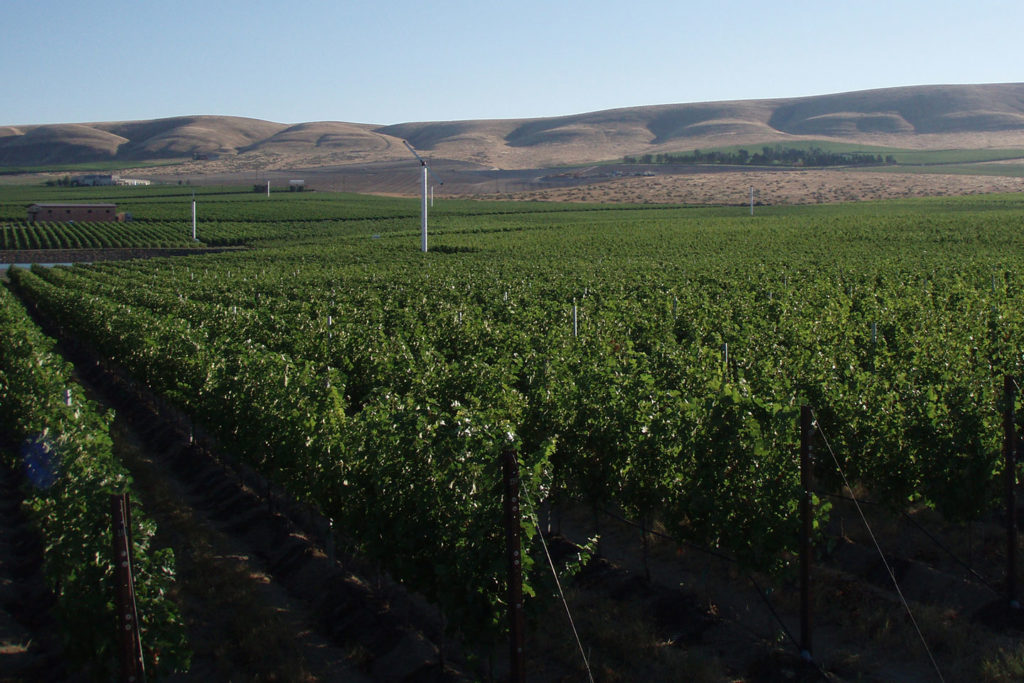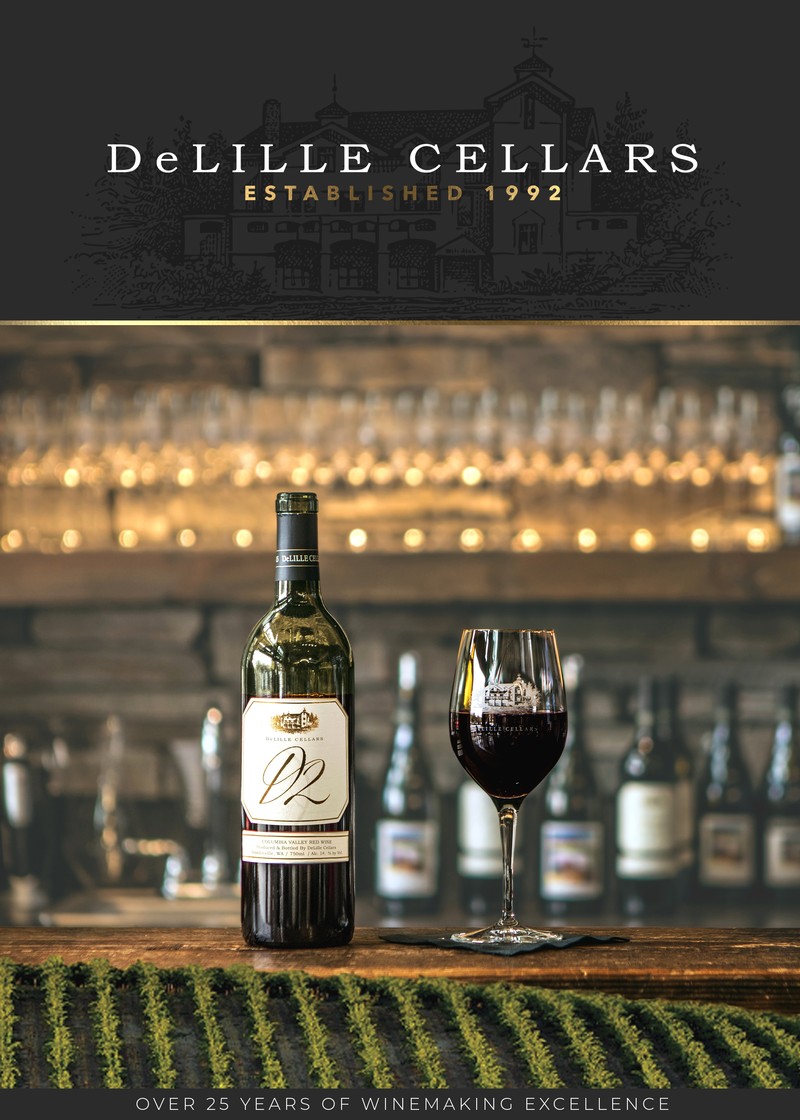Wine Game Changes on Red Mountain
Washington’s “grand cru” wine region could be about to get even better, W. Blake Gray reports.
By W. Blake Gray/Wine Searcher | Posted Tuesday, 09-Apr-2019
Red Mountain is one of the trendiest AVAs in the United States. Its name describes not what the mountain usually looks like – it’s actually desert-gray, with green when the vines are in bloom – but what the wines usually taste like. It’s famous for big, ripe Cabernets: some of the best in the country, yet much cheaper than Napa’s best.
But Red Mountain, a young AVA, is in transition. In 1985, there were just 60 planted acres and the site was unknown to all but the geekiest of wine fans. Now two extremely expensive projects at opposite ends of the mountain promise to permanently change its reputation in very different ways.
On the very peak, which once seemed unplantable, former Microsoft executive Cam Myhrvold (brother of the food engineer Nathan) is paying a fortune to grow mostly Rhône-style grapes in an attempt to replicate the savory French-style wines he loves. He had no experience in grape growing, or farming at all, but he didn’t let that or any other obstacles stop him. And he’s not planning to open a winery – he plans to sell all his grapes and hopes top winemakers like Chris Peterson at Avennia make great wines from them.
“I don’t want this to sound arrogant, but I want to grow the best grapes in the world,” Myhrvold told Wine-Searcher. “I don’t know if we’ll ever get there, but you gotta try.”
In the foothills down to the border of Washington‘s smallest AVA, a billionaire family from Canada with plenty of farming experience – they’re reportedly the world’s largest producers of blueberries and cranberries – but no wine experience has become the region’s largest landholder. The Aquilinis, who also own the Vancouver Canucks hockey team, bought 535 acres of the AVA’s total of 4040 in an auction in 2013. They are also ambitious, though the kind of wine they want to make is very different from Myhrvold.
“I’m fortunate to have good financial backing,” said Barry Olivier, president of Aquilini Brands. “[Francesco Aquilini] says: ‘Give me a 100-point wine.’ “
The roughly two dozen vineyard owners who are already there can only look at the two projects – neither of which has any finished wine to show yet – and wonder about what the new neighbors will mean for their region.
“The Ryan Johnson plantings [for Myhrvold] are the most beautiful things I’ve ever seen,” Hedges Family Estate marketing director Christoph Hedges told Wine-Searcher.
Johnson is a long-established Red Mountain vineyard manager and a great front man for the Myhrvold project, now called WeatherEye. The Aquilinis, in contrast, until recently hired outsiders with no experience in the Washington wine community.
“[The Aquilinis] have gone from nothing to being the largest grower on Red Mountain,” says JJ Williams, proprietor of Kiona Vineyards, Red Mountain’s first winery. “For us, that’s kind of nerve-wracking. We’ve been here for 40 years. The reputation of Red Mountain hinges on all the wines being good.”
Williams has more perspective on Red Mountain than anyone; he grew up there. His father was one of the first to plant on the desolate spot in 1975, after a successful government research project showed that grapevines would thrive on the other side of the mountain from the Hanford nuclear plant that once produced most of the country’s weapons-grade plutonium.
It’s obvious now that Red Mountain has absolutely great terroir. But it wasn’t obvious in the 1970s. Hard winter freezes were the main worry, which is why many of the first plantings there and elsewhere in eastern Washington were Riesling. Most people didn’t immediately pay attention to the temperatures in summer.
The diurnal temperature shift – key to maintaining acidity in grapes – is immense; in summer, it’s often 95 degrees Farenheit (35C) during the day and 50 (10C) at night. The area is extremely dry, so there’s little pressure from the various fungi that plague most vineyards. Strong breezes keep the heat from being oppressive.
It’s a desert, but with a layer of topsoil, courtesy of the Missoula Floods more than 13,000 years ago that shaped most of the Pacific Northwest.
Red Mountain is Washington’s grand cru region, says Chris Upchurch, owner of Upchurch Vineyard and winemaker for DeLille Cellars. Upchurch built a house on Red Mountain because he got tired of frequently making the 3.5-hour drive from the vineyards to DeLille’s winery in Woodinville, a suburb of Seattle. (Woodinville has a HUGE wine scene because most winemakers would rather live near Seattle than near the grapevines.)
“There are very few places in the world where the wines have incredible structure and ripeness like Red Mountain has,” Upchurch says. “The Old World has structure; the New World has ripeness. We have both and we do it every year. My elevator pitch is, high-plains desert with soil. By only having seven inches of rain (annually), it’s legally a desert. Why doesn’t every desert plant grapes? Because they don’t have soil. We have soil. We imported it from Montana (in the Floods).”
Quilceda Creek was perhaps the first winery to garner cult wine acclaim on Red Mountain. Until Cayuse came on the scene, Quilceda Creek was the only Washington winery to get 100-point scores from the Wine Advocate, and while its wines once listed the massive Columbia Valley AVA (of which Red Mountain is a part), the winery’s Galitzine Vineyard on Red Mountain always played an important part. Now it is the basis of a single-vineyard Red Mountain wine.

Galitzine Vineyard
But the AVA’s reputation has also been built by many Woodinville-based wineries that buy fruit from the famous vineyards: Ciel du Cheval, Kiona, Heart of the Hill (also owned by Kiona) and Quintessence.
“All the things that make Washington a good place to grow wine grapes in general are magnified on Red Mountain,” Kiona’s Williams says. “Good sunshine. We get less rain here that Phoenix, Arizona. The soil is pretty sterile. Red Mountain wines are pretty tannic. Dark color. There’s an interesting level of mineral that comes through. There’s a dry, dusty, gravel aspect to it.”
Williams says Red Mountain grapes cost three to four times as much as those from the wider Columbia Valley.
“It goes into halo wines,” Williams says. “If people are trying to get scores, they’re using it. If you pick up a bottle of Red Mountain wine there’s a good chance it’s our grapes.”
That was true until now, but Kiona has only 270 planted acres and the Aquilinis now own 535 acres. They’re keeping aside what they believe are the best 60 acres to make their own wines from and plan to sell all the grapes from the rest. They harvested their first crop last year but had difficulty selling it because of a lack of connections, and also because Washington’s largest winery by far, Chateau Ste Michelle, had a bad year business-wise and didn’t buy as many grapes as usual, creating a statewide grape surplus.
Given the AVA’s increasing international reputation, that surplus situation probably won’t last forever. Duckhorn is on Red Mountain with its own Canvasback vineyard. The Antinori family from Tuscany is there with Col Solare, a vineyard and winery. Everybody wants into Red Mountain, but after the Aquilini purchase there isn’t much left to plant.
That makes the Myhrvold project particularly interesting. It’s so different from the rest of the vineyards. For one thing, as in most of eastern Washington, there are a lot of varieties planted in the AVA, but Kiona’s Williams says, “Cabernet is king on Red Mountain.”
But the WeatherEye project is mostly Rhône varieties, including an impressive effort in planting Mourvèdre on the ridgeline, with an individual mound of rocks to protect every individual vine from wind.
“I love Rhône wines,” Myhrvold told Wine-Searcher. “Last night I had a Rene Rostaing La Landonne Côte-Rôtie. Unbelievable. I love the wines from Paso Robles: Saxum, Booker. I’ve tasted a few vintages of Château Rayas. That’s wonderful.”
Johnson, the WeatherEye vineyard manager, visited Christophe Baron’s high-density plantings at Cayuse in The Rocks district, about 45 minutes away, and has replicated it for a block of Grenache although, unlike Baron, he won’t use horses to plow it. Instead, showcasing his tech background, Myhrvold intends to use modified bomb-disposal robots.
“I was at dinner with Cam (Myhrvold) and we had (Baron’s) Horsepower Grenache,” Johnson said. “By the time we were done, we said, God dang it, we’ve got to do something like this.” [Writer’s note: Johnson has lived in the countryside all his adult life and he actually said “dang”, something I haven’t heard in the wicked city in years.]
In 2004, Myhrvold bought the ridge property, above even Force Majeure’s plantings near the mountaintop, but he had no water rights, no plans and no wine industry experience. Eventually he could get the water rights and his ambition came to fruition.
It’s striking to see a line of young lavender plants being irrigated in their own spot among WeatherEye’s numerous individual plots. The idea is that the lavender will combine with the native sagebrush – which they left right in the middle of the rocky vineyards and planted around – to give WeatherEye grapes a touch of the “garrigue” aroma famous in the south of France.
The view from WeatherEye is amazing: you can see the entirety of the Red Mountain AVA easily, along with the Horse Heaven Hills, and, on the other side, steam rising from the nuclear plant.
“It’s a beautiful place, but there’s a fierceness to the beauty,” said Johnson, who occasionally comes upon scorpions sunning themselves. It’s actually warmer at the top of the mountain than down below, but the wind can be extreme.
“Cam told me, give me an estimate for how much it’s going to cost so I can consider that money gone,” Johnson said. “This doesn’t make economic sense, but that’s not what drives us.”
As for what drives the Aquilinis at the bottom end of the mountain, other than wanting a 100-point wine, family patriarch Luigi Aquilini just likes farming. Just as he conquered the blueberry and cranberry markets, so he is on the verge of conquering the Red Mountain AVA wine grape market, at least in the macro sense. Their own Aquilini brand wines were made by consulting winemaker Philippe Melka and are in tanks and barrels right now, waiting to appear on the world stage. Melka knows what he’s doing, so nobody’s worried about how they will affect the AVA’s reputation.
But those other hundreds of acres of grapes?
“It’s taken some time to break down barriers to show that we’re not idiots,” said Aquilini’s Olivier. “That we’re going to do right by this terroir.”


